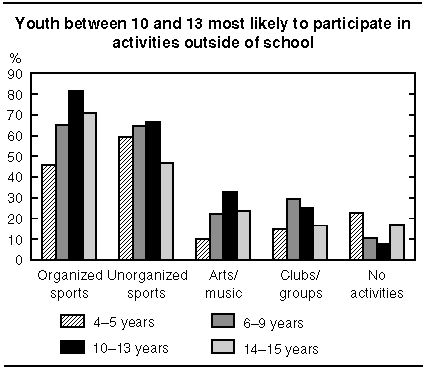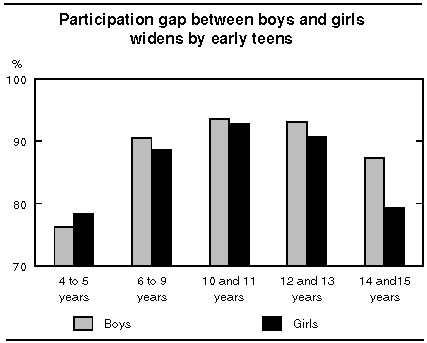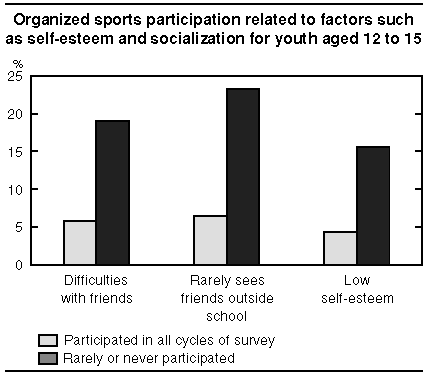
















 |
|
 |                |
Archived ContentInformation identified as archived is provided for reference, research or recordkeeping purposes. It is not subject to the Government of Canada Web Standards and has not been altered or updated since it was archived. Please "contact us" to request a format other than those available. 
The Daily. Wednesday, May 30, 2001 National Longitudinal Survey of Children and Youth: Participation in activities1998/99Children who participate in organized activities outside of school such as sports, music, the arts or clubs tend to have higher self-esteem, interact better with friends and perform somewhat better in school, according to new data from the National Longitudinal Survey on Children and Youth (NLSCY). Data from the third collection cycle of the NLSCY show an estimated 87% of Canadian children aged 4 to 15 participated in organized activities outside of school, leaving about 13% of children who rarely or never participated. The data indicate, for example, that among young people aged 12 to 15, those who rarely or never participated in organized sports were more likely to report having lower self-esteem and difficulties with friends. They were also more likely to smoke. The findings in this report are based on a first analysis of new data for children aged 4 to 15 in 1998/99, as well as an analysis of longitudinal data, spanning four years for young people who were between ages 12 and 15 in 1998/99.
It is important to note that the relationship between participation in activities and outcomes such as self-esteem or behaviour towards others is complex and difficult to measure. This analysis only notes these relationships. Clearly more analysis will be required to determine whether participation contributes to causing specific outcomes, whether children with certain outcomes tend to participate more than others or whether the relationship between participation and positive outcomes is simply symptomatic of some other underlying cause. Participation in activities peaked by early teensIn 1998/99, participation in activities among children aged 4 to 15 tended to peak by early teens, with almost 92% of children aged 10 to 13 participating in some type of activity. This proportion dropped to 83% among young people aged 14 and 15. For sports-related activities, younger children were more involved in unorganized sports, those without a coach or instructor, while older children tended to participate in sports with a coach. Participation in arts or music was most frequent among young people aged 10 to 13, while belonging to clubs or groups was most frequent among those aged 6 to 9 years. Among younger children, participation rates showed little difference between boys and girls. Boys were somewhat less likely to participate at 4 or 5 years of age, while girls were slightly less likely to participate between the ages of 6 and 11. 
Among teenagers, however, differences between the sexes were more evident. By the age of 14 or 15, an estimated one in five girls indicated they were not participating in any activity, compared with about one in 10 boys. At all ages, boys were more likely than girls to be participating in organized and unorganized sports. Girls, on the other hand, were found to be participating more in arts or music, and clubs or groups. 
Low income a barrier to participationResearch has shown that certain groups of children tend to face more barriers to participation in activities than others. NLSCY data showed that in 1998/99, children who were least likely to participate in organized activities were those in lower income families, those with very young parents, those whose primary care-giver had less than a high school education and those in single-parent families. These factors were more likely to act as barriers to participation for younger children, those aged 4 to 9, than for older children aged 10 to 15. Younger children in the lowest income quartile were three times more likely to have never participated in organized activities (sports, music, arts or clubs) than children in the highest quartile. Younger children whose parent had less than a high school education were more than twice as likely to have never participated in organized activities than were those children whose parent had higher education. Younger children who participated tended to have positive school outcomesFor the most part, 76% of parents reported that their children were doing very well or well in school. Preliminary findings show that children between the ages of 4 and 9 who participated in activities, particularly sports, tended to have fewer difficulties in reading or math than those who rarely or never participated. In the NLSCY, a test designed to measure receptive or hearing vocabulary is administered to children between 4 and 6 years of age. In 1998/99, 29% of those who had little or no involvement in activities showed delayed development in vocabulary, about twice the proportion (13%) of those who had participated in activities. Research has indicated that children who participate in activities generally gain and improve skills, as well as learn how to interact with others. According to their parents, younger children who had little or no involvement in activities were twice as likely to exhibit lower levels of pro-social behaviour, indicating a relationship between activity participation and socialization skills for young children. Over long term, regular sports activities linked to higher self-esteem and better healthThe NLSCY collects data from the same respondents every two years. As a result, it is possible to examine activity participation over time, that is, longitudinally. The following section focusses on a four-year time period for the same youths, aged 12 to 15 in 1998/99, who were between the ages of 8 and 11 when the NLSCY began in 1994/95. Data show that 11% of these youth had never or rarely participated in organized sports with a coach or instructor; 39% had never or rarely participated in arts or music; and 51% had never or rarely participated in clubs or groups over the four years of collection for the survey. Given that the number of older children participating in activities other than organized sports was relatively small, the analysis focusses only on youth who participated in organized sports. Among teens, as with younger children, participation in activities appears to be related to social skills. Teens who had rarely or never participated in organized sports over the four years of the survey reported that they were much less likely to see their friends outside school and were more than three times as likely to report problems with friends. 
Studies have shown that one potential long-term benefit of participating in sports activities is increased self-esteem. NLSCY data show a relationship between activity participation and self-esteem for older children. Some 16% of youth who had rarely or never participated in sports reported low levels of self-esteem, four times higher than those who had always participated. In addition, youth who had participated in organized sports in 1994/95 and 1996/97, but had stopped participating by 1998/99, were three times more likely to report lower levels of self-esteem than those youth who had always participated. Youth who participated in organized sports regularly over the years were more likely to report that expressing their opinion was important, and they had a more positive outlook on their personal futures in the next five years. While one-third of youth aged 12 to 15 indicated that they were not happy with how they looked, the proportion was much higher among those who had never or rarely participated (42%) than among those who had always participated (24%). This same pattern prevailed among youth trying to lose weight. Some 25% of youth who had always participated in organized sports indicated they were trying to lose weight, compared with 40% of those who rarely or never participated, or stopped participating. In all cases, more females than males reported trying to lose weight. While the majority of youth reported that they were in excellent or very good health, the proportion was higher among those who participated regularly in sports over time (90%) than for those who had rarely or never participated (70%). It is important to note that, in some instances, it may be poor health that prevents participation in sport (e.g., a severe disability), while in other cases it may be inactivity that leads to poor health. Finally, of the youth who had never or rarely participated in organized sports between 1994/95 and 1998/99, 23% reported that they smoked, almost three times the proportion of those who always participated (8%). Again, those who stopped participating by 1998/99 were twice as likely to report that they smoked than those who had always participated. While findings demonstrate a relationship between participating in extracurricular activities and some positive outcomes such as improved health, higher self-esteem, and improved emotional and social skills, there is not enough analysis to date to infer that participation causes these outcomes. In order to better understand the complex interactions between these variables, more detailed analysis will be required. For more information about this release, including survey concepts, methods and data quality, contact Lecily Hunter (613-951-0597; lecily.hunter@statcan.gc.ca) or Sylvie Grenier (613-951-0477; sylvie.grenier@statcan.gc.ca), Statistics Canada, or Satya Brink (613-953-6622; satya.brink@spg.org.ca), Human Resources Development Canada. Data are also available by custom tabulations. For more information about tabulations and other products and services, contact Client Services (1-888-297-7355; 613-951-7355; fax: 613-951-3012; ssd@statcan.gc.ca), Special Surveys Division. |
|
|
|